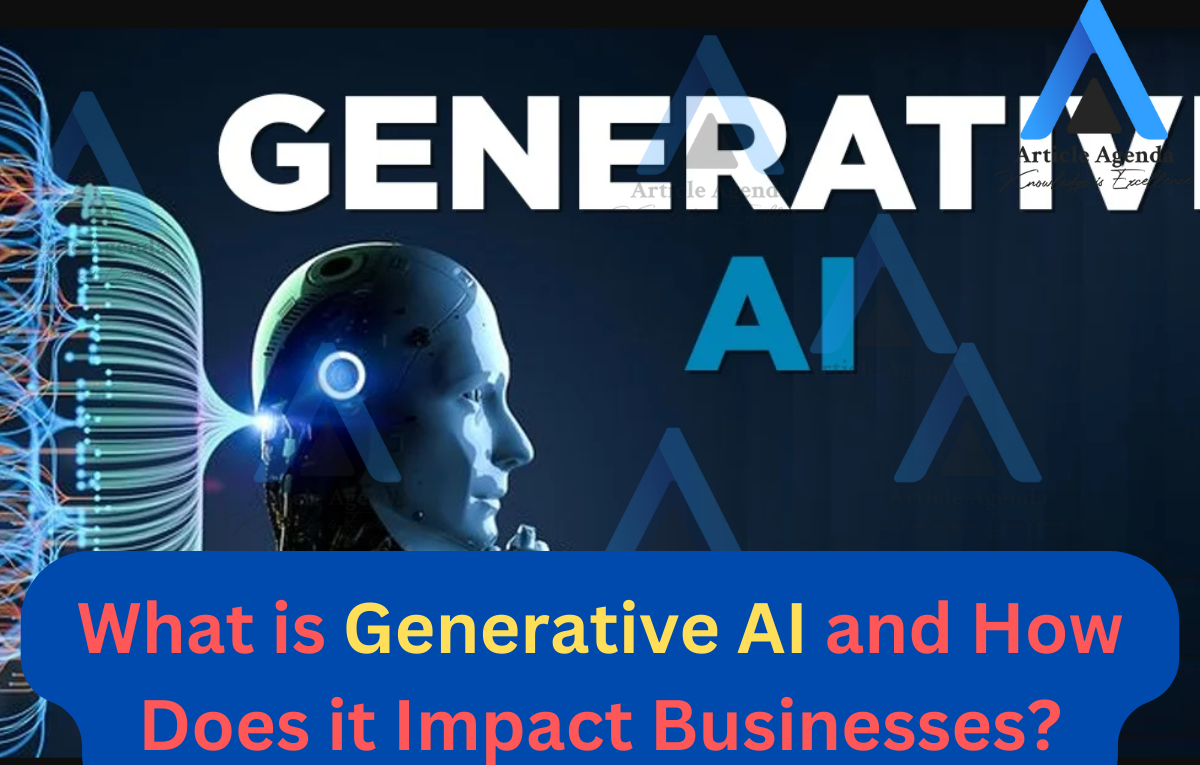Introduction to generative AI
Artificial Intelligence (AI) has become an integral part of our lives, revolutionizing various industries and enhancing our daily experiences. One fascinating aspect of AI is generative AI, which holds the power to create original content, ranging from images and music to even entire stories. In this article, I will delve into the world of generative AI, exploring its basics, applications, benefits, challenges, ethical considerations, and its promising future.
Table of Contents
Understanding the basics of AI
Before we dive into generative AI, it’s essential to grasp the fundamentals of AI itself. AI refers to the simulation of human intelligence in machines that are programmed to think, learn, and problem-solve like humans. It encompasses various subfields, including machine learning, natural language processing, and computer vision. Traditional AI systems are designed to follow predefined rules and patterns, but generative AI takes things a step further by generating new content without explicit instructions.
Read More: What is Generative AI and How Does it Impact Businesses?
What is generative AI?
Generative AI, also known as generative adversarial networks (GANs), is a subset of machine learning that focuses on generating new, original content. Unlike traditional AI models that rely on pre-existing data, generative AI has the ability to create something entirely new. It involves two components: a generator network and a discriminator network. The generator network creates new data instances, while the discriminator network distinguishes between real and generated data. These two components work together in a competitive and iterative process, continually improving the generator’s ability to create authentic content.
Read More: Google Generative AI
How does generative AI work?
Generative AI operates on a unique framework called generative adversarial networks (GANs). GANs consist of two neural networks, the generator and the discriminator, which are pitted against each other. The generator network is responsible for creating new content from random noise, while the discriminator network tries to differentiate between real and generated data. Through an iterative process, the generator network continuously improves by learning from the discriminator’s feedback, aiming to generate content that is indistinguishable from real data.
The training process of generative AI involves feeding the GANs with a large amount of training data, allowing them to learn the patterns, styles, and characteristics of the input data. As the training progresses, the generator network becomes more proficient in generating realistic content, while the discriminator network becomes more adept at distinguishing real from generated data. This adversarial relationship constantly pushes the boundaries of what generative AI can achieve.
Read More: Which career is better, AI and CS?
Applications of generative AI
Generative AI has found applications in various fields, opening up new possibilities and transforming industries. One prominent application is in the field of art and design. Generative AI can create unique and visually stunning pieces of art, challenging traditional notions of creativity. It can also be utilized in music composition, generating original melodies and harmonies that evoke different emotions.
Another area where generative AI has made significant strides is in the gaming industry. Game developers can use generative AI to create realistic and dynamic game environments, characters, and narratives. This enables more immersive and captivating gaming experiences for players.
Generative AI also holds promise in the field of healthcare. It can be used to generate synthetic medical images, aiding in the diagnosis and treatment of various diseases. Additionally, generative AI can assist in drug discovery by simulating the effects of different compounds, potentially speeding up the development of new medications.
Examples of generative AI in practice
Several examples highlight the incredible capabilities of generative AI in practice. One notable example is the work of artist Robbie Barrat, who utilized generative AI to create unique and visually striking artworks. His AI-generated art pieces have been exhibited in galleries around the world, showcasing the potential of generative AI as a creative tool.
Another example is the popular deepfake technology, which utilizes generative AI to swap faces in videos. While deepfakes have raised ethical concerns, they demonstrate the power of generative AI in generating highly realistic and believable content. Deepfakes have been used in various industries, from entertainment to politics, sparking important discussions about the implications of this technology.
Read More: Exploring the Role of Computer Engineers in Artificial Intelligence Development
Benefits and challenges of generative AI
Generative AI offers numerous benefits, but it also comes with its own set of challenges. One of the significant advantages of generative AI is its ability to create original content quickly and efficiently. This can be particularly valuable in creative industries where fresh ideas are constantly in demand.
However, generative AI also faces challenges. One challenge is the potential for biases in the generated content. If the training data used to train the AI models contains biases, it can be reflected in the generated content, perpetuating societal biases. It is crucial to carefully curate the training data to mitigate these biases and ensure fairness in the output.
Read More: Mastering AI: A Domain of Computer Science or Electrical Engineering?
Ethical considerations of generative AI
Generative AI raises important ethical considerations that need to be addressed. The creation of deepfakes, for instance, has sparked concerns about misinformation, identity theft, and the erosion of trust. As generative AI becomes more advanced, it is essential to establish guidelines and regulations to prevent malicious use and protect individuals’ rights.
Another ethical concern is the potential impact on employment. Generative AI has the potential to automate creative tasks, potentially displacing artists, designers, and other creative professionals. It is crucial to find a balance between the capabilities of generative AI and the preservation of human creativity and craftsmanship.
Read More: Unlocking the Potential: The Best Double Major Pairings with Computer Science for AI
The future of generative AI
As generative AI continues to advance, the possibilities seem endless. The technology has already made significant strides in various domains, and its potential is only growing. In the future, we can expect generative AI to continue revolutionizing creative industries, enabling new forms of art, music, and storytelling.
Additionally, generative AI holds promise in fields such as medicine and scientific research. It can aid in the development of new drugs, simulate complex biological processes, and generate synthetic data for research purposes. The potential applications of generative AI are vast and exciting, promising to reshape our world in profound ways.
Read More: Should I study computer science or artificial intelligence?
Conclusion
Generative AI is a fascinating branch of AI that has the power to create original content. It operates on the principles of generative adversarial networks, where a generator network and a discriminator network work together to generate authentic content. While generative AI presents numerous benefits and opportunities, it also poses challenges and ethical considerations that need to be carefully addressed.
As this technology continues to evolve, it is crucial to strike a balance between the capabilities of generative AI and the preservation of human creativity. With the right regulations and guidelines, generative AI has the potential to enhance our lives, transform industries, and push the boundaries of human imagination. The future of generative AI is bright, and we are only beginning to scratch the surface of its true potential.
CTA: To learn more about the exciting world of AI and its applications, visit our website and explore our informative articles and resources. Join us in shaping the future of technology and innovation.
Latest Post:
-
Smart Home Appliances in the UAE: Revolutionizing Modern Living
The UAE has long been recognized as a hub for innovation and technological advancement, and the adoption of smart home appliances is no exception. As the nation embraces the concept of smart homes, residents are experiencing a transformation in their daily lives, characterized by increased convenience, efficiency, and sustainability. This article explores how smart home…
-
(Artificial Intelligence) AI and ML (Machine Learning) : Transforming the Future
Artificial Intelligence (AI) and Machine Learning (ML) are two of the most transformative technologies of our time. They are reshaping industries, driving innovation, and opening up new possibilities in ways previously unimaginable. This article explores the fundamentals of AI and ML, their applications, and their profound impact on various sectors. Understanding Artificial Intelligence (AI) What…
-
Digital Marketing Services: Transforming Your Business in the Digital Age
In today’s digital-first world, businesses must leverage digital marketing services to remain competitive, attract customers, and drive growth. Digital marketing encompasses a broad range of tactics and strategies aimed at promoting products or services through digital channels. This article delves into the various types of digital marketing services available, their benefits, and how businesses can…





Thanks for another excellent post. Where else could anybody get that type of information in such a perfect way of writing? I’ve a presentation next week, and I am on the look for such information.
Hey! Do you use Twitter? I’d like to follow you if that would be ok. I’m absolutely enjoying your blog and look forward to new posts.
Today, while I was at work, my sister stole my iphone and tested to see if it can survive a forty foot drop, just so she can be a youtube sensation. My iPad is now broken and she has 83 views. I know this is entirely off topic but I had to share it with someone!
My brother suggested I might like this website. He was once totally right. This submit actually made my day. You cann’t consider simply how much time I had spent for this information! Thank you!
What Is Java Burn? Java Burn is a natural health supplement that is formulated using clinically backed ingredients that promote healthy weight loss.
An impressive share, I just given this onto a colleague who was doing a little analysis on this. And he in fact bought me breakfast because I found it for him.. smile. So let me reword that: Thnx for the treat! But yeah Thnkx for spending the time to discuss this, I feel strongly about it and love reading more on this topic. If possible, as you become expertise, would you mind updating your blog with more details? It is highly helpful for me. Big thumb up for this blog post!
I genuinely enjoy reading on this internet site, it contains fantastic blog posts. “The living is a species of the dead and not a very attractive one.” by Friedrich Wilhelm Nietzsche.